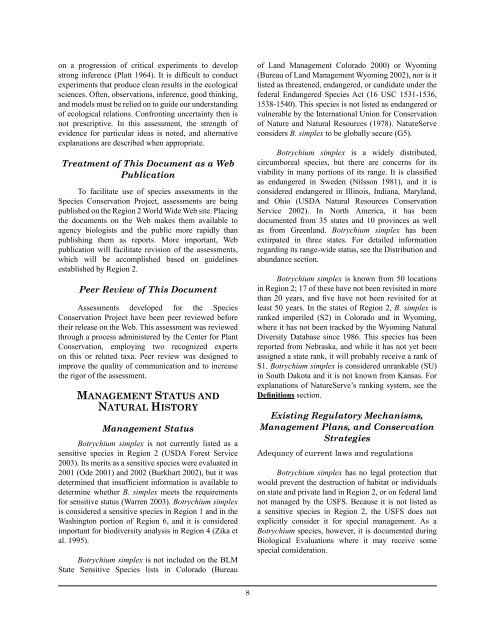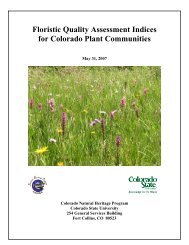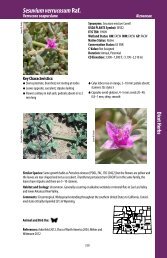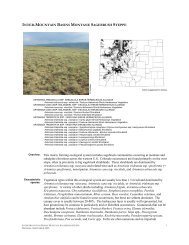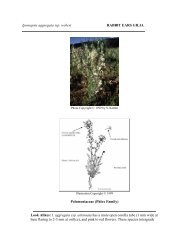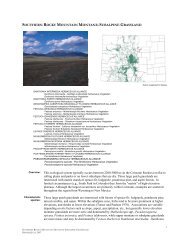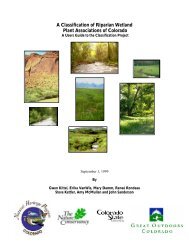Botrychium simplex E. Hitchcock (little grapefern) - Colorado Natural ...
Botrychium simplex E. Hitchcock (little grapefern) - Colorado Natural ...
Botrychium simplex E. Hitchcock (little grapefern) - Colorado Natural ...
Create successful ePaper yourself
Turn your PDF publications into a flip-book with our unique Google optimized e-Paper software.
on a progression of critical experiments to develop<br />
strong inference (Platt 1964). It is difficult to conduct<br />
experiments that produce clean results in the ecological<br />
sciences. Often, observations, inference, good thinking,<br />
and models must be relied on to guide our understanding<br />
of ecological relations. Confronting uncertainty then is<br />
not prescriptive. In this assessment, the strength of<br />
evidence for particular ideas is noted, and alternative<br />
explanations are described when appropriate.<br />
Treatment of This Document as a Web<br />
Publication<br />
To facilitate use of species assessments in the<br />
Species Conservation Project, assessments are being<br />
published on the Region 2 World Wide Web site. Placing<br />
the documents on the Web makes them available to<br />
agency biologists and the public more rapidly than<br />
publishing them as reports. More important, Web<br />
publication will facilitate revision of the assessments,<br />
which will be accomplished based on guidelines<br />
established by Region 2.<br />
Peer Review of This Document<br />
Assessments developed for the Species<br />
Conservation Project have been peer reviewed before<br />
their release on the Web. This assessment was reviewed<br />
through a process administered by the Center for Plant<br />
Conservation, employing two recognized experts<br />
on this or related taxa. Peer review was designed to<br />
improve the quality of communication and to increase<br />
the rigor of the assessment.<br />
MANAGEMENT STATUS AND<br />
NATURAL HISTORY<br />
Management Status<br />
<strong>Botrychium</strong> <strong>simplex</strong> is not currently listed as a<br />
sensitive species in Region 2 (USDA Forest Service<br />
2003). Its merits as a sensitive species were evaluated in<br />
2001 (Ode 2001) and 2002 (Burkhart 2002), but it was<br />
determined that insufficient information is available to<br />
determine whether B. <strong>simplex</strong> meets the requirements<br />
for sensitive status (Warren 2003). <strong>Botrychium</strong> <strong>simplex</strong><br />
is considered a sensitive species in Region 1 and in the<br />
Washington portion of Region 6, and it is considered<br />
important for biodiversity analysis in Region 4 (Zika et<br />
al. 1995).<br />
<strong>Botrychium</strong> <strong>simplex</strong> is not included on the BLM<br />
State Sensitive Species lists in <strong>Colorado</strong> (Bureau<br />
8<br />
of Land Management <strong>Colorado</strong> 2000) or Wyoming<br />
(Bureau of Land Management Wyoming 2002), nor is it<br />
listed as threatened, endangered, or candidate under the<br />
federal Endangered Species Act (16 USC 1531-1536,<br />
1538-1540). This species is not listed as endangered or<br />
vulnerable by the International Union for Conservation<br />
of Nature and <strong>Natural</strong> Resources (1978). NatureServe<br />
considers B. <strong>simplex</strong> to be globally secure (G5).<br />
<strong>Botrychium</strong> <strong>simplex</strong> is a widely distributed,<br />
circumboreal species, but there are concerns for its<br />
viability in many portions of its range. It is classified<br />
as endangered in Sweden (Nilsson 1981), and it is<br />
considered endangered in Illinois, Indiana, Maryland,<br />
and Ohio (USDA <strong>Natural</strong> Resources Conservation<br />
Service 2002). In North America, it has been<br />
documented from 35 states and 10 provinces as well<br />
as from Greenland. <strong>Botrychium</strong> <strong>simplex</strong> has been<br />
extirpated in three states. For detailed information<br />
regarding its range-wide status, see the Distribution and<br />
abundance section.<br />
<strong>Botrychium</strong> <strong>simplex</strong> is known from 50 locations<br />
in Region 2; 17 of these have not been revisited in more<br />
than 20 years, and five have not been revisited for at<br />
least 50 years. In the states of Region 2, B. <strong>simplex</strong> is<br />
ranked imperiled (S2) in <strong>Colorado</strong> and in Wyoming,<br />
where it has not been tracked by the Wyoming <strong>Natural</strong><br />
Diversity Database since 1986. This species has been<br />
reported from Nebraska, and while it has not yet been<br />
assigned a state rank, it will probably receive a rank of<br />
S1. <strong>Botrychium</strong> <strong>simplex</strong> is considered unrankable (SU)<br />
in South Dakota and it is not known from Kansas. For<br />
explanations of NatureServe’s ranking system, see the<br />
Definitions section.<br />
Existing Regulatory Mechanisms,<br />
Management Plans, and Conservation<br />
Strategies<br />
Adequacy of current laws and regulations<br />
<strong>Botrychium</strong> <strong>simplex</strong> has no legal protection that<br />
would prevent the destruction of habitat or individuals<br />
on state and private land in Region 2, or on federal land<br />
not managed by the USFS. Because it is not listed as<br />
a sensitive species in Region 2, the USFS does not<br />
explicitly consider it for special management. As a<br />
<strong>Botrychium</strong> species, however, it is documented during<br />
Biological Evaluations where it may receive some<br />
special consideration.


